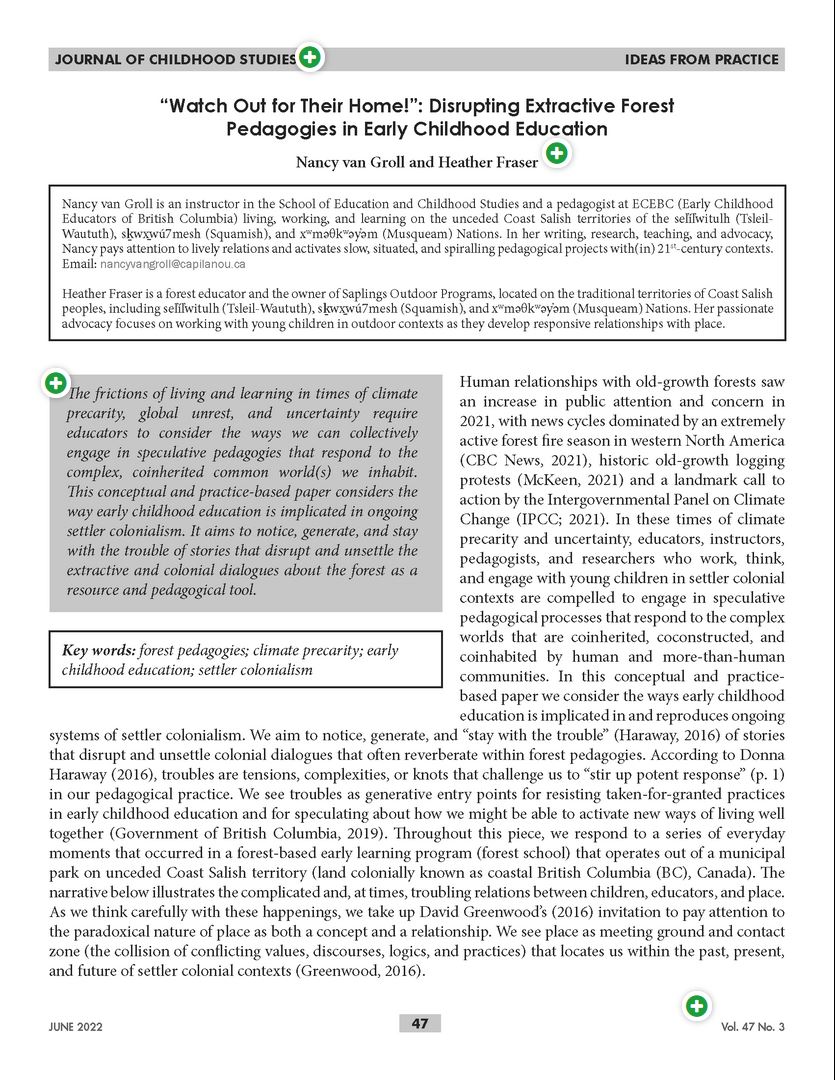Source Type: Journal Article Cues
In the following source type examples, examine the different sources and click on the ![]() symbol to learn about each cue that helps identify a source’s type.
symbol to learn about each cue that helps identify a source’s type.
First, we will examine a scholarly journal article.
Explore: A scholarly journal article found in the Library database
Explore: A scholarly journal article found in the Library database (Text version)

The record in the library database search results displays the following information:
Name of the article: “Watch Out for Their Home!”: Disrupting Extractive Forest Pedagogies in Early Childhood Education. Click on the title of the article to view more information about the resource, a brief description of the work, and options to access, save or email the article.
Expert Authors: Nancy van Groll and Heather Fraser
Journal information: Journal of childhood studies (Prospect Bay), 2022, p.47-53. Peer reviewed. Open Access.
Access options: Click Get PDF to access the whole article in PDF format. Click Available Online for other access options.
Activity source: “Source Type: Journal Article Cues” In APA Style Citation Tutorial by Sarah Adams and Debbie Feisst, University of Alberta Library, used under CC BY-NC-SA 4.0 . / Screenshot of peer-reviewed journal article updated. Article displayed: Van Groll, & Fraser, H. (2022). “Watch Out for Their Home!”: Disrupting Extractive Forest Pedagogies in Early Childhood Education. Journal of Childhood Studies (Prospect Bay), 47–53. https://doi.org/10.18357/jcs202219894 , licensed under CC BY-NC. Screenshot of Primo database is used under Fair Dealing.
Explore: First page of a scholarly journal article
Explore: First page of a scholarly journal article (text version)

Pedagogies in Early Childhood Education by Nancy van Groll and Heather Fraser, CC BY-NC 4.0
Name of the Journal: Journal of Childhood Studies
Expert Authors: Nancy van Groll and Heather Fraser
Abstract: The frictions of living and learning in times of climate precarity, global unrest, and uncertainty require educators to consider the ways we can collectively engage in speculative pedagogies that respond to the complex, coinherited common world(s) we inhabit. >This conceptual and practice-based paper considers the way early childhood education is implicated in ongoing settler colonialism. It aims to notice, generate, and stay with the trouble of stories that disrupt and unsettle the extractive and colonial dialogues about the forest as a resource and pedagogical tool.
Volume and Issue Number: Vol. 47 No. 3
Activity source: “Source Type: Journal Article Cues” In APA Style Citation Tutorial by Sarah Adams and Debbie Feisst, University of Alberta Library, used under CC BY-NC-SA 4.0 . / Screenshot of peer-reviewed journal article updated. Article displayed: Van Groll, & Fraser, H. (2022). “Watch Out for Their Home!”: Disrupting Extractive Forest Pedagogies in Early Childhood Education. Journal of Childhood Studies (Prospect Bay), 47–53. https://doi.org/10.18357/jcs202219894 , licensed under CC BY-NC.
Source Type: Journal Article Cues
Name of the journal
Journal articles are collected and published in scholarly journals. Often (but not always), the word “journal” in the scholarly journal’s name is a good indicator. Look for the name of the journal in the document header (top left or right corner of each page in the article), or document footer. For peer reviewed journals, the name of the journal typically appears in the top half of the first page, often in the left-hand corner.
Volume & Issue number
Volume and issue numbers are most commonly used with journal articles and scholarly journals. Look for these following the name of the journal and the date/year of publication, typically in the header or footer of the document. They may be written as: Volume 35, No. 3 or 35(3). The page numbers of the article are often located near the Volume and issue number.
Expert authors
Articles are written by experts in their field who often have high levels of education and professional experience. Their experience may be included in the article. In journal articles, the author’s names are often listed immediately under the article title.
Abstract
Abstracts are usually found in journal articles and provide a summary of an article’s research findings. Often this summary of the article will be found in the top half of the first page of the article. Some journals use a shaded box to make the abstract stand out from the rest of the text, and abstracts are usually labeled accordingly.
More information found in the library database entry
If you’re looking at journal articles in a library database, you can often find a marker that indicates that the material has been peer reviewed. It may be specifically stated, or you may also see the “source type” indicating a scholarly journal.
- Peer reviewed: Scholarly journal articles are peer-reviewed by subject experts. Peer-review indicators may be found in database or library catalogue descriptions or on the journal article (article received, article accepted).
- Source type: Library catalogue and database descriptions often identify the source type of a work.
Attribution & References
Except where otherwise noted, this chapter is adapted from “8.3 – Source Type: Journal Article Cues” In Communication Essentials for College by Emily Cramer & Amanda Quibell, licensed under CC BY-NC 4.0 :
- “Source Type: Journal Article Cues” In APA Style Citation Tutorial by Sarah Adams and Debbie Feisst, University of Alberta Library, used under a CC BY-NC-SA 4.0 International License. / Adaptations include updates for accessibility and notes on fair dealing use.
- Kirkpatrick, L., Brown, H. M., Searle, M., Smyth, R. E., Ready, E. A., & Kennedy, K. (2018). Impact of a one-to-one iPad initiative on Grade 7 students’ achievement in language arts, mathematics, and learning skills. Computers in the Schools, 35(3), 171-185. https://doi.org/10.1080/07380569.2018.1491771 [Screenshots of scholarly journal article (in the H5P activities) are used under Fair Dealing.]

